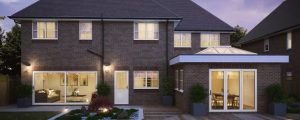Windows play a crucial role in both the functionality and aesthetics of a home. When designing or renovating a house, choosing the right window style can impact energy efficiency, insulation, ventilation, and overall appearance. Two popular window styles that homeowners and architects often consider are recessed windows and flush windows.
But what exactly sets these two window types apart? In this blog, we will explore the differences, advantages, disadvantages, and best use cases for recessed and flush windows to help you determine which one is right for your home.
What Are Recessed Windows?
Recessed windows are installed inside the exterior wall, meaning they are set back from the outer surface of the building. This creates a visible depth or “recess,” forming a small alcove or ledge around the window.
Characteristics of Recessed Windows
- Set deep into the wall, creating a layered or shadowed effect.
- Often used in traditional or classical architecture but can also complement modern designs.
- Provide extra insulation and shade, reducing direct sunlight exposure.
- Can create a cozy seating space or decorative shelf inside.
Advantages of Recessed Windows
- Better Insulation & Energy Efficiency – Since they are embedded within the wall, recessed windows provide better thermal insulation, reducing heat loss in winter and keeping interiors cool in summer.
- Enhanced Aesthetics – The depth of recessed windows adds architectural detail, creating a sophisticated and stylish look.
- Improved Soundproofing – The deeper installation helps in reducing external noise, making them ideal for homes in busy or noisy areas.
- Protection from Rain & Sun – The recessed design provides natural shade, reducing glare and heat while also preventing excessive rain exposure.
Disadvantages of Recessed Windows
- Less Natural Light – Since recessed windows are set back, they allow less sunlight into the room compared to flush windows.
- Challenging Cleaning & Maintenance – Dust and debris can accumulate on the ledge, requiring regular cleaning.
- Higher Installation Cost – Requires thicker walls and additional construction work, making them more expensive than flush windows.
What Are Flush Windows?
Flush windows are installed in line with the exterior wall, meaning the window frame sits level with the surface of the building. This creates a sleek and modern look without any visible depth.
Characteristics of Flush Windows
- Installed flat with the exterior wall, providing a smooth, uniform surface.
- Frequently used in modern, contemporary, and minimalist architecture.
- Maximizes natural light, allowing more sunlight to enter the space.
- Easier to clean and maintain compared to recessed windows.
Advantages of Flush Windows
- Sleek & Modern Appearance – Flush windows offer a clean, seamless design that enhances the look of contemporary homes.
- More Natural Light – Since they sit flush with the wall, they allow more sunlight to enter, brightening up interiors.
- Easy Maintenance – Without a deep frame or ledge, dust and dirt buildup is minimal, making cleaning easier.
- More Space-Efficient – Flush windows do not protrude inward or outward, making them ideal for compact spaces.
Disadvantages of Flush Windows
- Less Insulation – Since they are not embedded within the wall, flush windows offer less thermal insulation compared to recessed windows.
- More Exposure to Weather Elements – Since they are directly exposed, they are more susceptible to rain, heat, and wind damage over time.
- Less Depth for Decoration or Seating – Unlike recessed windows, flush windows do not provide extra space for window seats, shelves, or decorative ledges.
When to Choose Recessed Windows vs. Flush Windows?
Here is what you should keep in mind about choosing recessed windows vs flush windows –
- Best for Recessed Windows
- Homes in hot or noisy areas where insulation and soundproofing are important.
- Classic, rustic, or European-style homes that benefit from deep window placements.
- Rooms that need built-in shelves or cozy seating areas near the window.
- Homes with thicker walls that can accommodate the recessed installation.
- Best for Flush Windows
- Modern, contemporary, and minimalist homes where sleek aesthetics matter.
- Rooms that need maximum natural light to enhance brightness.
- Homes in urban settings where space-saving window designs are beneficial.
- Homeowners looking for low-maintenance and easy-to-clean window options.
Which One Should You Choose?
The choice between recessed and flush windows depends on your home’s architectural style, insulation needs, and personal preferences.
- If you prioritize energy efficiency, insulation, and a textured architectural look, go for recessed windows.
- If you want a sleek, modern aesthetic with maximum natural light and minimal maintenance, flush windows are the better option.
It’s also important to consider the climate and location of your home. In colder regions, recessed windows are preferable due to their insulation properties, while flush windows are ideal for homes in warmer, sunnier climates where natural light is a priority.
Conclusion
Both recessed and flush windows have their unique benefits and drawbacks. Recessed windows offer better insulation, soundproofing, and a classic look, while flush windows provide a modern, sleek aesthetic with more natural light.
Choosing the right type of window depends on your design preferences, energy efficiency needs, and overall home style. Whether you opt for recessed or flush windows, make sure they align with your comfort, budget, and architectural goals.
Looking to upgrade your windows? Consult with a professional to determine the best option for your home!


